Gas
Going Backwards: DFW’s Annual Smog Average Went Up Twice in Two Days Last Week
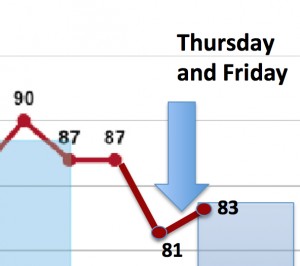 State officials and industry PR types thought they'd caught a break last summer when two things produced a much lower annual smog average, called a "Design Value."
State officials and industry PR types thought they'd caught a break last summer when two things produced a much lower annual smog average, called a "Design Value."
Since it's a three-year rolling average of smog numbers, past years roll off as new ones come on. Smog numbers from 2011 that had been so high they'd sent the average soaring, were finally rolling off and wouldn't be included in the average.
Second, unusually cooler temperatures and rain kept a new round of numbers lower. Combined, these factors resulted in a significant decrease in the smog average for 2014.
But in 2015, a more typical summer, or at least August, is bringing the average back up (Over 60% of the 100 highest recorded levels of smog this summer occurred in the last 30 days). Smog levels are higher across the board this year than last. There are more monitors recording more "exceedences" of the national smog standard. Leading them all is the Denton monitor, which saw ozone levels rise on Thursday and then skyrocket on Friday. The numbers were so high on both days they moved the needle of the annual smog average, the DFW Design Value, up from 81 to 82 parts per billion (ppb) on Thursday and up to 83 ppb on Friday. The standard is 75 ppb.
Even though Houston has recorded higher smog numbers than DFW this year, 2014's lower smog numbers was even more anomalous for that city than for North Texas. Last year's much lower numbers in the Bayou City are canceling out this year's much higher numbers. So that in 2015, DFW's Denton monitor's annual average of 83 ppb is the highest in the State of Texas.
And that means that according to the official accounting of the Clean Air Act, DFW has dirtier air than Houston. And not for the first time.
It also means we're rolling backwards in terms of air quality progress. With at least a whole month of "ozone season" to go, DFW's smog average is now only a little lower than it was in 2009. It would only take one or two more bad days to raise the average again.
This is the second time in four years that DFW's smog average has increased during the implementation of a state clean air plan for the area. Neither plan required new controls on large industrial polluters significantly contributing to the problem, like the gas industry, East Texas coal plants, and Midlothian cement kilns. There may be some connection there.
Given the state's stellar two decade-old track record of never meeting a clean air plan deadline, its latest plan was always likely to fail. But a federal court roll back of the deadline to get to the 75 ppb standard at all DFW monitors, from 2018 to 2017, plus these new 2015 smog numbers, make it DOA in the real world.
However, in the regulatory world governing these things officially, the plan is still being reviewed by the EPA and, believe it or not, could get approved if citizens don't make a big stink.
That's why you need to sign our Change.org petition to EPA to reject the state's plan and send an email to EPA officials requesting they write a new clean air plan instead of the state of Texas.
Many clean air advocates cautioned that 2014 should be seen as a outlier, and this summer is justifying that caution. If the experts are right, climate change will mean future summers will be more like 2011 than 2014. We've got to have a more realistic approach to the goal of safe and legal air. The State of Texas will not provide that. EPA can.
Sept 23rd: Dallas is Site to One of Three National Public Hearings on EPA’s New Methane Rules – Speak Up to Include Them in Current Air Plan
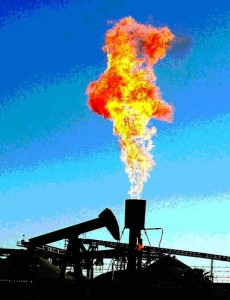 Hot off the presses, the EPA published notice in this morning's Federal Register that Dallas will be the site of one of only three national public hearings the Agency is hosting concerning its proposed rules designed to reduce methane emissions at new oil and gas indusry facilities.
Hot off the presses, the EPA published notice in this morning's Federal Register that Dallas will be the site of one of only three national public hearings the Agency is hosting concerning its proposed rules designed to reduce methane emissions at new oil and gas indusry facilities.
On September 23rd, from 9 am until 8 pm in the Dallas City Council Chambers, the EPA will be accepting testimony from the public, in five-minute increments. You can register for your five minute slot online at www.epa.gov/airquality/oilandgas/ between now and September 18th.
Announced to great fanfare only last week, the rules promise to cut future pollution levels as new equipment comes on line, but does nothing about existing faciltiies – with one important exception.
For metropolitan areas like DFW that host large concentrations of gas pollution sources AND are in violation of the Clean Air Act for their smog pollution, EPA has said that states must address new “Control Technique Guidelines” written by the Agency to reduce missions of Volatile Organic Compounds as part of thier smog-figthing plans for those areas. That's good because its smog-forming VOC pollution like Benzene and Toluene that also makes up some of the most toxic air pollution these facilities can emit. The catch is that the rules give the states a two year grace period.
That means that even though the State of Texas and EPA are wrestling over a clean air plan for DFW right now, and even though one of the major smog-polluting industries in DFW are the 17,000 or so wells, almost 700 large compressors and thousands of other oil and gas facilities in North Texas, those new Control Guidelines will not have to be included in that current plan. But they should be.
If you're going to testify, please be sure to make the request that the EPA and Texas go ahead and include these "VOC CTGs" for non-attainment areas in the current DFW air plan. These are anti-smog measures that are no-brainers in a region which has never been in compliance with the Clean Air Act. And they also mean a total reduction in hazardous air pollution.
For more information about the public hearings, contact Ms. Aimee St. Clair, Office of Air Quality Planning and Standards (E143–03), U.S. Environmental Protection Agency, byphone at (919) 541–1063, or by email at StClair.Aimee@epa.gov.
The Impact of the EPA’s New Methane Rules on the Barnett Shale? TBD
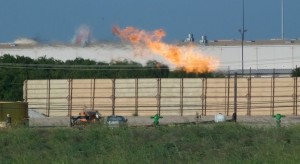 Despite all the gnashing of teeth by industry and hallelujah choruses from the Big Green groups, the new methane rules proposed by the Obama Administration this last week have no immediate impact on facts on the ground in the Barnett Shale.
Despite all the gnashing of teeth by industry and hallelujah choruses from the Big Green groups, the new methane rules proposed by the Obama Administration this last week have no immediate impact on facts on the ground in the Barnett Shale.
That’s because, like the recent coal CO2 rules, they regulate future facilities, not the 17,000 or so wells, plus infrastructure, already operating in the Barnett.
They do bring a welcome spotlight to “downstream” facilities like gathering lines and compressors, which is where most of the methane in the gas fuel cycle escapes. They also concede the connection between methane releases and smog (“…reduction of VOC emissions will be very beneficial in areas where ozone levels approach or exceed the National Ambient Air Quality Standards for ozone”), as well as methane and more toxic Volatile Organic Compounds such as Benzene and Toluene (“The measures proposed in this action achieve methane and VOC reductions through direct regulation. The hazardous air pollutant (HAP) reductions from these proposed standards will be meaningful in local communities.”)
EPA’s new rules set a floor for emissions that the industry, over time, will eventually get closer to meeting as a while with the turnover of equipment. But that could take decades. Meanwhile, the agency is only offering “guidelines” to states with smog problems – like Texas – for new pollution controls to reduce methane at existing facilities.
Under this part of the regulation, areas like DFW that host large concentrations of gas pollution sources and are officially categorized as “non-attainment” for smog, or ozone, standards will supposedly be the beneficiaries of new EPA-written “Control Technique Guidelines.”
According to EPA, these CTGs “provide an analysis of the available, cost-effective technologies for controlling VOC emissions from covered oil and gas sources. States would have to address these sources as part of state plans for meeting EPA’s ozone health standards.”
If you live in Texas, you’ve already chortled at that last sentence. Really? The Texas Commission on Environmental Quality (TCEQ) would have to use these new technologies on gas sources in their new clean air plans for DFW? Something they’ve refused to do for the last two clean air plan cycles dating back to 2010?
Well, they have to address them at least. And a lawsuit aimed at gutting the new rules is a form of addressing isn’t it?
These are guidelines only, up to the state to enforce – as the EPA admits. “States have some discretion in applying these guidelines to individual sources.” The leverage EPA has is that it still needs to approve these state-generated clean air plans and it can make an official determination that a state didn’t follow the guidelines and send it back to be amended.
This might not be all that important except that the State of Texas is going to have to write a new air plan for DFW in the next year or face the prospect of a federal plan being written in its stead. The one Austin submitted in July is already falling apart on several fronts, and TCEQ has to submit a whole new version or face an EPA-imposed one.
Will the state at least have to acknowledge these guidelines in this current air plan controversy? No. The states have two years to fold the proposed CTGs into their SIPs. So they don’t even have to come into play until this current state plan fails, and Austin or the EPA begin to write a replacement. And why might this plan fail? In part, because it doesn’t apply modern controls to major sources like oil and gas facilities.
You might remember in July, a total of 11 studies were collectively released that concluded the Barnett Shale was leaking 50 percent more methane than previously thought. The day before the EPA made its announcement this week, a national version of those studies estimated US methane pollution from oil and gas was being underestimated by 30%. That’s important because many models of air pollution used by the EPA and the states use those standard emissions estimates that now look obsolete. If you increase the amount of methane, and associated pollutants, by 30-50% in those models, the results might look very different.
So even though the state isn’t officially required to include this new approach to decreasing VOC pollution until 2017 or later, it’d be nice to see it adopted now and have an immediate impact on a region that has a longstanding chronic smog problem. But as long as Texas is in charge of writing DFW’s air plans, that’s just not gong to happen.
That Didn’t Take Long: Fracking Resumes in Denton. Because It Can
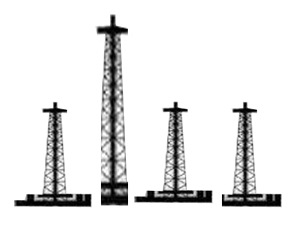 As its way of giving Denton residents an industrial size middle finger, the Denton Record Chronicle is reporting that Vantage Energy is preparing to begin fracking in the city on May 27th. The company's announcement came a day after Governor Abbott signed a new law prohibiting local governments from banning fracking, or, really, doing much of anything to hinder whatever the hell gas companies want to do in a city.
As its way of giving Denton residents an industrial size middle finger, the Denton Record Chronicle is reporting that Vantage Energy is preparing to begin fracking in the city on May 27th. The company's announcement came a day after Governor Abbott signed a new law prohibiting local governments from banning fracking, or, really, doing much of anything to hinder whatever the hell gas companies want to do in a city.
Usually, new laws take effect the following September 1st after a session, but the Governor and industry wanted to make sure they was no summer of doubt holding-up their smack down. Until yesterday, Denton city representatives were sounding prepared to continue defending their ban from industry court challenges, but the new law keeps them from being able to file preliminary injunctions to halt resumption of fracking itself.
Because the Vantage site sit on the edge of town and is more than 1200 feet from a "protected use," like a home, the new activity is not a direct challenge to Denton's off-set regulations, or the ambiguous lynch-pin language of "commercially reasonable" driving the newly-signed legislation. And because the Vantage operation was under way when the city declared a year-long moratorium on new fracking in 2014, it could ask for, or assume it has, a hardship case under that local rule.
So only 200 days or so after it took effect the disassembling of Denton's fracking ban will begin. Because it can.
After it was clear the legislation would become law, most citizen observers expected such a demonstration of political spite by industry, although many were predicting it would be lead by Eagle Ridge's resumption of fracking in the original neighborhood by the UNT stadium that kicked off the entire controversy. This first baby-step back into town isn't quite so in-your-face, but it may be opening the doors.
What is the appropriate response by angry Denton residents to this news in the short term? Is it a picket line outside the site's fence? That would certainly attract media for a day but it wouldn't have much impact on the operators. Is it civil disobedience to stop the trucks from entering or leaving the site? That would get even more attention, but unless you have wave after wave of demonstrators lined-up and organized, this too seems like it's a temporary inconvenience rather than a real threat. On the other hand, if this is not the time and place to register your discontent by risking arrest, what does such a place and time look like?
There are lots of rumors about a court challenge to the new state legislation, but that will take years to play out in the courts, and remember, unless there's a constitutional challenge, they'll be Texas state courts, where the judges are all elected, not appointed.
The choices facing Denton residents are the same facing every other group of concerned fracktivists in the state right now – they're just facing them sooner. No option looks very satisfying. Most cities are cowering at the thought of enacting new off-sets or rules and taking on industry and running up millions in legal bills. Individual nuisance suits against operators offer some hope to the most extreme examples, but not necessarily to victims as a class. Legal challenges to the state law itself offer a very long maze of trials and rulings. Up to now, the way citizens have organized themselves has not been conducive to national relief and even if that weren't true you have an Administration relying on the fracking boom for much of its energy policy and so reluctant to crack down on it. Incrementalism has never seemed so incremental.
New strategies are needed, but right now nobody can't see clearly what those will be. One thing you can count on however. When citizens are frustrated and angry over being shat on involuntarily, and you don't allow them to express that anger and frustration into what they believe to be meaningful mechanisms for change, you back them into a corner. Take away the reasonable options, and suddenly, the "unreasonable" ones are the only ones available and they have nothing left to lose in taking them. Just Google "Chinese parents + pollution" and see what kind of tactics you push people into pursuing when they don't have a system that responds to their real and present dangers.
Not many people remember the modern American anti-toxics movement was born with a hostage crisis.
Love Canal was a toxic dump for chemical waste used by the Hooker Chemical Company in the 1950s in Niagara Falls, New York. In the next 20 years two schools and 900 homes were built on or near Love Canal. A young housewife, Lois Gibbs, lived there, and led a precedent-setting fight against the federal government to get all the families relocated.
At one point in 1980 when EPA officials visited the community, Lois Gibbs and her group refused to let the officials leave until the federal government promised to relocate the families. That's right, the group held the EPA officials hostage.
"Yes, I say we detained them for their own protection! That’s actually what got us the relocation. EPA had come down and told us all the things we couldn’t do, and then said we had chromosome breakage, and chromosome breakage means that we have a higher risk of cancer, birth defects, and miscarriages. But the thing that really broke the…sort of the straw that broke the camel’s back was when they said it’s not just about the adults in the community, these chromosome breakages could be in your children, and people just panicked. And they all came to this front lawn of the abandoned house where we had our offices, and they’re all looking at me, it’s like, “Lois, what are we going to do?” and I’m thinking like, “My goodness, I’m going to be a target here because people are so angry.” So I called the EPA representatives to the house to explain to the larger group, what does this mean? And when they got there, people said, “you know what? If it’s so darn safe for us, it can be safe for you. And we’re going to hold you in this house until President Carter does the right thing”.
So they were in the house and 500 people literally encircled the house and sat down, so they couldn’t get out. But after a while, it got really rowdy out there, people were feeding off of one another and they were getting angry. The FBI said they were going to come in and they were going to take the hostages from us if we don’t let them go. So we gave the White House…we let them go, kept them for five hours, and we let them go and gave the White House an ultimatum. They had until Wednesday at noon to evacuate us, or the hostage holding as it was coined, would look like a Sesame Street picnic to what we would do Wednesday at noon. We had no plan for Wednesday at noon! We had no clue what was going to happen Wednesday at noon, but I didn’t go to jail, and in fact, one of my hostages sent me a telegram – which young people today may not know that is – but sent me a telegram that said, “I hope you win everything you guys are fighting for. Thank you for the oatmeal cookies. Your happy hostage, Frank.”
New Study Finds Dangerous Levels of Toxic Air Pollution From Fracking
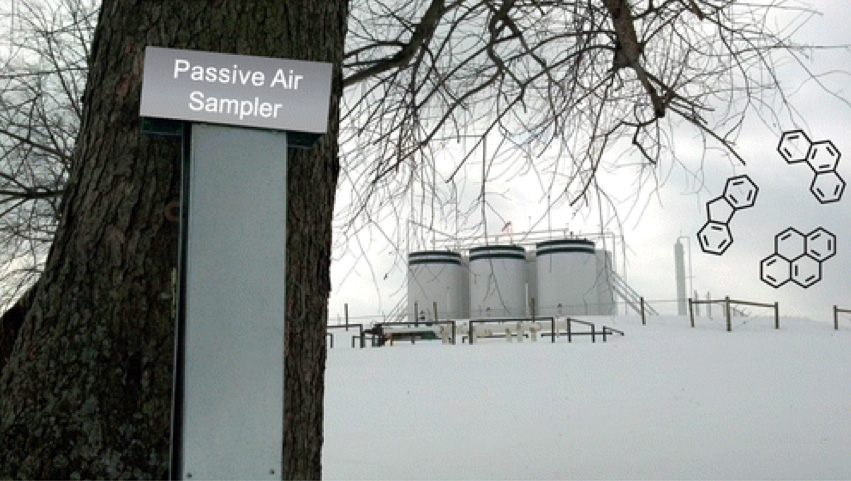 People living or working near active natural gas wells may be exposed to toxic air pollution at higher levels than the Environmental Protection Agency considers safe for lifetime exposure. That's the conclusion of a new study performed by scientists from Oregon State University and the University of Cincinnati, published in the March 26th edition of the journal Environmental Science and Technology.
People living or working near active natural gas wells may be exposed to toxic air pollution at higher levels than the Environmental Protection Agency considers safe for lifetime exposure. That's the conclusion of a new study performed by scientists from Oregon State University and the University of Cincinnati, published in the March 26th edition of the journal Environmental Science and Technology.
Sampling at various sites adjacent or downwind of fracking wells in Carroll County, Ohio over a three-week period last February revolved around 62 Polycyclic Aromatic Hydrocarbons (PAHs), a category of combustion-produced pollutants already linked too everything from childhood obesity to breast cancer, to lower IQ. Carroll County sits on top of the Utica formation, a gas rich shale deposit. The rural county is a hotspot of natural gas drilling and production, with more than one active well site per square mile.
“Air pollution from fracking operations may pose an under-recognized health hazard to people living near them,” said the study’s coauthor Kim Anderson, an environmental chemist with OSU’s College of Agricultural Sciences.
The study was initiated by citizens in the area who wanted to more about the health risks they were facing from fracking. They approached Anderson her peers and and the scientist designed the study to include citizen participation. They placed air samplers on the properties of 23 volunteers living or working at sites ranging from immediately next to a gas well to a little more than three miles away.
Anderson's samplers are aluminum T-shaped boxes containing specially treated polyethylene ribbons that absorb contaminants in a similar manner to biological cells. Volunteers were trained in proper handling of samplers and documenting of data.After the study period, the volunteers packaged the samplers in airtight bags, labeled them and mailed them back to Anderson’s lab at OSU.
Even the lowest levels – detected on sites more than a mile away from a well – were higher than previous researchers had found in downtown Chicago and near a Belgian oil refinery. They were about 10 times higher than in a rural Michigan area with no natural gas wells.
By looking at the ratios of individual PAHs detected by the samplers, Anderson and her team were able to discern whether they came directly from the earth – a “petrogenic” source – or from “pyrogenic” sources like the burning of fossil fuels. The proportion of petrogenic PAHs in the mix was highest nearer the wells and decreased with distance.
The team also accounted for the influences of wood smoke and vehicle exhaust, common sources of airborne pyrogenic PAHs. Wood smoke was consistent across the sampling area, supporting the conclusion that the gas wells were contributing to the higher PAH levels.
The researchers then used a standard calculation to determine the additional cancer risk posed by airborne contaminants over a range of scenarios. For the worst-case scenario (exposure 24 hours a day over 25 years), they found that a person anywhere in the study area would be exposed at a risk level exceeding the threshold of what the EPA deems acceptable.
The highest-risk areas were those nearest the wells, Anderson said. Areas more than a mile away posed about 30 percent less risk.
Estimated worst-case maximum residential exposure was 2.9 in 10 000, which is above the U.S. EPA’s acceptable risk level of one in a million. According to the study's abstract, "This work suggests that natural gas extraction may be contributing significantly to PAHs in air, at levels that are relevant to human health."
Poll: Public Support for Local Control of Fracking is Strong, Will Have No Impact on Texas Legislature
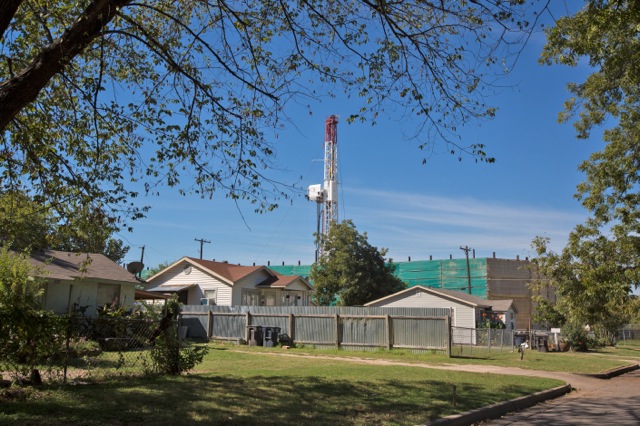
From the Too Little Too Late Department comes news that a new UT poll finds that 53% of Texans want cities to have the power to control where fracking takes place in their jurisdictions, even to the point of banning it, a la Denton. That number rises to 58% nationally. The poll surveyed 2,078 people from March 4th -13th from across the country and has a margin of error of 3 percentage points.
Considering that legislation to restrict that right sailed through the Texas House of Representatives by a vote of 118 to 22 and is on a fast track to be approved by the Texas Senate any day now, the poll's results should have exactly zero impact. Because 53% of Texan didn't get sizable campaign contributions from the oil and gas industry but about that same percentage of the Texas Legislature did.
The Last Frack Fight?
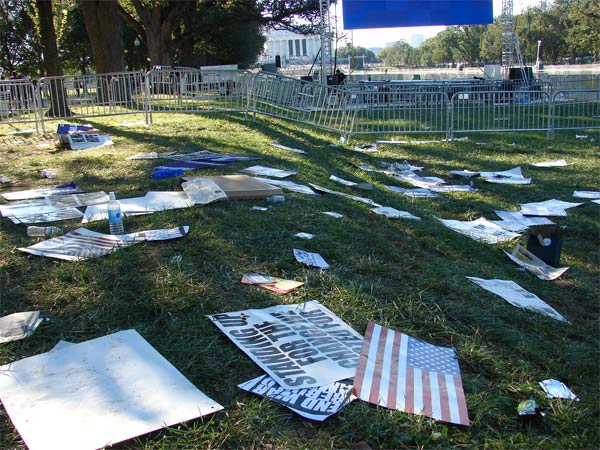
In Austin, the HB 40 hearing started late and continued far into the night. In Mansfield, the third reading of the new ordinance with the old setbacks was following the script. Between the apocalyptic tweets emanating from the one and the dismal Kabuki theater playing out in the other, it was hard to tell. Was this the beginning of the end, or the end of the beginning?
If the Texas legislature has its way, the long hard two-year slog from outraged neighborhood to fourth (or was it the fifth?) revision of the city's gas drilling ordinance that concluded at the Mansfield City Hall Monday night might be the last Old School Home Rule fracking fight the Barnett Shale sees for some time. But unlike, Southlake, or DISH, or Dallas, this one didn't end with unqualified victory for the residents.
Timing is everything, and the Mansfield fight was peaking at exactly the wrong time with the wrong group of timid elected officials. Before Denton, and the Banshee legislative session of 2015, it might have been possible to get longer setbacks. But now, it was out of the question. The City Council was unanimous in its reluctance to piss off Austin any further by extending a buffer zone past 600 feet, or pass something for the hell of it that would be repealed in a matter of months anyway. There was way more discussion and debate over a proposed assisted-living facility than the proximity of another 300 gas wells to 50,000 people.
For almost two months, the industry had been pushing back hard, with telephone campaigns, Astroturf websites, and industry reps parachuting into nearly every Chamber of Commerce and business association meeting. Trade associations pumped money into the fight like their collective lives depended on it. And maybe they did. Mansfield is in Tarrant County, the Belly of the Barnett Shale Beast, and in territory it thought it had bought and paid for years ago. The very idea!
Which makes what Mansfield Gas Well Awareness did over the last year that much more remarkable. It clawed its way into the city council's agenda after being blown off with promises they'd be "no fracking on Sundays." It kept the issue in front of City Hall's face until the council agreed to revise the ordinance again. It did that with a handful of people, lots of determination, and no money. In Ed Ireland's backyard, they took on the gas industry and kept getting further down the field.
And so while Monday was a disappointment compared to the goals of the original campaign, in many respects, it was also a draw. Despite all the money spent by industry, supporters of a stronger ordinance with longer setbacks turned out in equal number to the line-up of realtors and royalties owners who liked things just the way they are.
Mansfield kept is archaic 600 foot setback, a relic from 2008. On the other hand, for the first time anyone could recall, there was a provision added that requires the notification to potential homebuyers within 300 feet that they're moving into close proximity to a gas well. That's important. An educated homebuyer is the movement's best friend. Other cities should expand on this concept of notification – especially since it may be one of the only ways left soon to influence the industry at the local level. Call it the Right-to-Know Who Your Industrial Neighbors Are.
And while the city council voted against them, one of the rank and file of Mansfield Gas Well Awareness is now running for council. Tamera Bounds declared her candidacy in late February. She's taking on long, long, long time incumbent Cory Hoffman. A victory by Bounds would send a strong message to City Hall that the reactive form of regulation it now favors isn't proactive enough.
One of the most interesting things about Monday night was the rhetoric deployed by either side. Because Mansfield has over 200 wells already, there was no shortage of anecdotal information about wells gone wrong or what living next door to one was really like. Many of the supporters of longer setbacks talked about their own first-hand experience. The ones who didn't do that spoke with first hand knowledge of reading specific studies and the survey of peer-reviewed, journal-published scientific literature now available. It was all very fact-based. Here's what I saw/smelled/breathed. Here's what I read.
What was funny was that the canned speeches from industry accused them of using scare tactics (Science! Experience!) and importing ideas from Russia (seemingly unaware that the former Soviet Union is now in vying with Texas for world headquarters of crony capitalism). Presentations by the proponents of the status quo talked about how sacred property rights are in Texas and America, how everything is awesome with the city, and how everything would be terribly un-awesome if there wasn't gas drilling. But they never cited one study, never mentioned a statistic, or related how research was proving them right about the safety of proximity to wells. Any objective literary comparison would find all the scare tactics and exaggerated rhetoric unmoored to any scientific facts coming from the side that was accusing their opponents of using this very approach. Ironic, huh?
You'll also be glad to know that, according to Mr. Ireland, the gas industry produces "no air pollution," so those numbers (97 tons per DAY of Volatile Organic Compounds and Nitrogen Oxides) in the last state air plan that placed gas facilities as the single largest non-mobile source of smog-causing pollution in DFW were just, you know, numbers – as opposed to his more authoritative assertions). Lucky for Ireland the industry still has so much money to spread around to sell its case. If it's ever left up to his intellect alone, it's in big trouble.
At the conclusion, you kept asking yourself if that's all they had? Boiler plate "you're a socialist" dribble combined with climate change-like denial of the scientific research. It's all flag and dollar waving. But in March of 2015, in Mansfield, Tarrant County, Texas, it was enough to deny another 900 feet of protection to residents.
Back in Austin, Energy Resources Chairman Drew Darby's own bill drew 100 plus speakers, many from Denton and other cities that had already had their fights. The Texas Municipal League said over 300 Texas cities wouldn't be able to enforce their own gas drilling regulations if HB 40 became law. No new ordinances would be allowed.
In the past, you wouldn't expect such an extreme piece of legislation to pass, except it's 2015, the two-thirds rule, and Wendy Davis, are gone in the Senate, even some "liberal" Democrats are being enticed by industry money, there are no such things as moderate Republicans anymore, and oh, yeah, Denton. Has there been another single college town since Berkeley that set off more over-the-top reactionary alarms?
And so it's possible that the final unsatisfying unanimous vote in Mansfield on Monday night could be the conclusion to Texas' last local fracking fight. Beginning of the end, or end of the beginning?
Mansfield Misdirection: Med Waste Hype vs. Gas Industry Reality
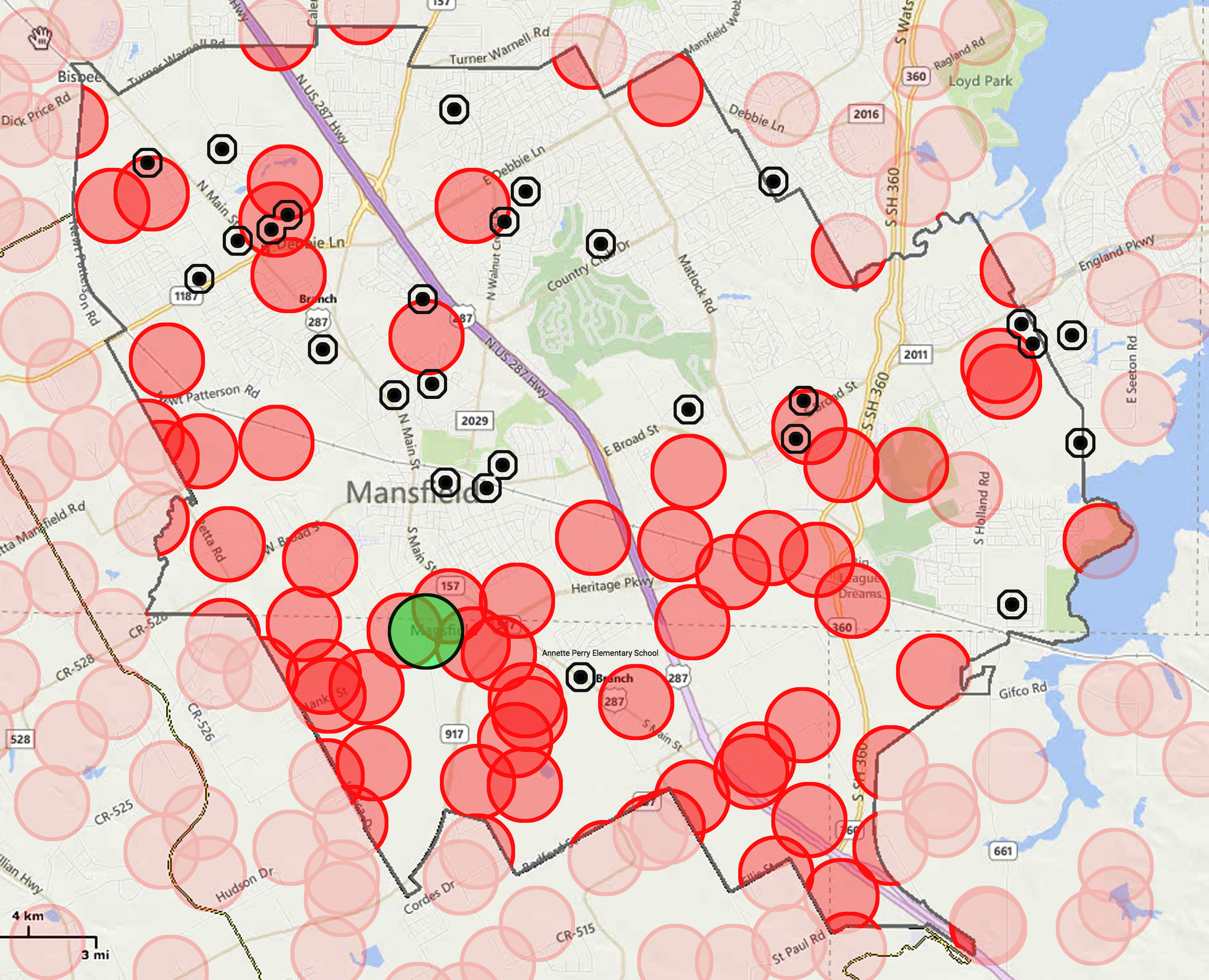
The green dot is a 1500-foot radius around a medical waste transfer station. The red dots are 1500-foot radiuses around gas wells. The black dots are schools. Guess which dot the City Council and School Board are outraged about?
2nd Reading of Proposed Gas Drilling Ordinance
Mansfield City Council Meeting
Monday Night, March 16th 6:30 pm
City Hall, 1200 E. Broad Street
In the art of slight-of-hand, there's a classic maneuver called misdirection. It's when the trickster forces the attention of an audience to focus on one thing in order to distract its attention from another.
In 2015, the largest, most egregious act of political misdirection in North Texas is taking place in Mansfield. With its 60,000 residents surrounded on all sides by 200 plus gas wells, emitting tons of toxic air pollution in the middle of residential neighborhoods, and next to schools and parks, official outrage is focused on the siting of a single medical waste transfer station that will release…no toxic pollution at all.
Oh, the Redaway transfer station application has lots of salacious wording. It will take in tons of "animal waste, bulk blood, bulk human blood, bulk human body fluids, microbiological waste, pathological waste, sharps, and other health care-related items that come into contact with body fluids and/or blood) and non-hazardous pharmaceuticals." Nasty stuff. But it will take this waste, put it in one of three large steam autoclaves, sterilize it, and ship it out to be buried at municipal solid waste landfills elsewhere. All inside an enclosed structure. This isn't a disposal facility. This isn't an incinerator. It's a place where medical waste comes in, gets Martinized, and then gets shipped back out.
But wait, there's tons of storage and up to 50 trucks a day of come and go traffic. What if this is near a neighborhood or upwind of schools? You'd want this kind of facility far away from people. Like in an area zoned for industrial uses. Which it happens to be located in. The nearest school is over a mile away, the nearest residential neighborhood almost as far.
Yet even this distance is way too close for comfort for the City Council and School Board. They don't even want the transfer station in the city limits. For these officials, there's no setback far enough to be safe from the dangers of escaped body parts. They're outraged. They've passed resolutions condemning the facility. They've even protested to the Texas Commission on Environmental Quality!
What exactly is the public health threat posed by the transfer station? It's not air pollution. The steam autoclaves emit so little pollution they aren't even required to have a permit. Nor is it water pollution. Everything drains into the city sewer system. It's the perceived threat of icky stuff like body parts and animal wastes and the accidental contamination from HIV-infected needles that fall off the trucks. In an industrial park. A mile away or more from the nearest school or neighborhood. Behind a fence, inside a building.
Meanwhile there are 206 gas wells strewn throughout the city, emitting half a ton, a ton, or maybe more air pollution a year depending on the age, design and activity. Carcinogens, Mutagens, Endocrine Disrupters. Many of these wells are within 1500 feet of neighborhoods and schools. Some are within 600 feet – the current setback required by the city. Some schools and neighborhoods are within 600 hundred feet of multiple wells. These wells routinely release toxic pollution. These wells pose a threat of accidental release or explosion or fire.
Taking a conservative estimate of half a ton of pollution a year, these 206 current wells could be releasing over 100 tons of air pollution a year. But 300 more are planned too. That's another 150 tons of air pollution. And that's not even counting the compressors, dehydrators, tanks etc. that go along with having that many wells in your town. 250 tons of air pollution is a lot.
So let's review. According to the Mansfield City Council and the Mansfield School Board, even though there are no emissions, and no disposal activity, and it's located in an industrial park, there's absolutely no appropriate distance between the medical waste transfer station and any neighborhood or school in the city. 600 feet, 1500 feet, 5280 feet – it doesn't matter. There is no such thing as a safe buffer zone from this facility. Zero tolerance.
On the other hand, 600 feet is more than a safe distance for proximity of neighborhoods and schools to heavy industrial activity that drills deep holes in the ground, pumps thousands of gallons of toxic chemicals into those holes under pressure, forces underground explosions and then tries to contain and process the resulting releases of gas and liquid coming back up through those holes. 600 feet is OK for constant exposure to toxic chemicals at "low levels." 600 feet is an appropriate distance in case of serious accident, because you're only dealing with highly flammable and explosive substances, not gross human blood.
Now, the more cynical among us would claim that this official misdirection is due to the fact that the city, school system, and property owners aren't getting a percentage of the tipping fees for the tons of waste passing through the transfer station the same way they're getting royalties from those hundreds of gas wells. Take the money out of the gas wells and they might not be allowed so close to people. Let the medical waste station cut property owners in on the action, and it too might be welcomed as a jobs creator.
But by any objective test of current and potential threat, gas wells trump the medical waste facility. Just one gas well pumps more pollution into the atmosphere in a year than the transfer station will in a decade.
On Monday night the Mansfield City Council will have its "second reading" for its proposed updating of the town's gas drilling ordinance. Concerned residents will continue to push for longer setbacks from homes and schools than the existing 600-feet the new ordinance reaffirms. They aren't asking to kick gas wells out of the city, the way the city is with the transfer station. They're just asking for the same level of protection afforded other North Texas towns like Dallas, Southlake and Flower Mound.
Setbacks are crucial because they're one of the few proactive measures that can be taken to avoid harm from a gas well or compressor, rather than reacting to it after the fact.
Longer setbacks prevent as many people from being exposed to as as much pollution, both routine and as a result of accidents, leaks and "blowdowns." The more distance there is between people and heavy industry, the fewer risks to public health. Fewer respiratory problems. Fewer nose bleeds. Fewer cancers. Fewer birth defects. Longer setbacks are a reasonable response to the science in 2015.
But the city and school board are holding fast. Zero tolerance for body parts. 600 feet for toxic pollution. That's why it's important for concerned residents to show up on Monday and call BS on this hypocrisy.
During the month long Ebola panic in the U.S., not one citizen died of the disease that dominated the headlines. However, if statistical evidence from the CDC is to be believed, probably close to 600 people died from the flu during those same four weeks. Which was the greater public heath threat?
There is something truly frightening in the medical waste application. It's the breakdown of land use within Mansfield. As it turns out, the city is "28.6% residential , 3.7% commercial, 3.7% industrial and warehouse, 4.9% parks, 4.3% public/semi public, and 13.3% gas wells and rights-of-way." Gas drilling now takes up more land use in Mansfield than all the commercial, industrial and park property combined. With 300 more wells to go, the city is looking more and more like a large industrial park with pockets of residential development instead of the other way around.
But don't worry about that. Be concerned about the building in the corner of the industrial park steam-cleaning blood, needles and body parts.
Worried Much? Gas Industry Desperate to Hold Back Truth and Mansfield Ordinance Reform
 For almost a year, Mansfield residents have been trying to rewrite their city's drilling ordinance to better reflect the science surrounding the public health consequences of heavy industry taking place so close to people. During this entire time, and countless appearances before their city council, there has not been one Mansfield citizen who came forward and defended the current approach.
For almost a year, Mansfield residents have been trying to rewrite their city's drilling ordinance to better reflect the science surrounding the public health consequences of heavy industry taking place so close to people. During this entire time, and countless appearances before their city council, there has not been one Mansfield citizen who came forward and defended the current approach.
But now that the Mansfield council is ready to act on a new ordinance, the gas industry is doing exactly what it's always accusing their opponents of doing, sending outsiders in to invade the town and spread misleading information. And they're doing it in a big, desperate way. Let's just review what's happened in the last couple of weeks:
Industry hired a sleazy push polling firm to conduct a Mansfield campaign by phone that purposely misleads about the impact of the revisions to the ordinance being sought and makes personal attacks on the residents pursuing those revisions.
Sent in trade association speakers from Austin and Fort Worth to Mansfield to further mislead the business community about the revisions being sought.
Set up an e-mail site where industry employees, no matter where they live, send their comments to the Mansfield City Council, in opposition to any revisions.
And last night, (Sunday) the industry released a "study" purporting to show how safe the existing 600 foot setback was in Mansfield.
And these are just the things we know about right now. Having seen the huge multi-well Edge Resources permit get temporarily, but unexpectedly, tabled in January, the industry wasn't about to take any chances on seeing that happening again in their own back yard. So they've thrown everything and the kitchen sink into the Mansfield fight.
Of course, this reaction is a tremendous complement to the efforts of the intrepid Mansfield Gas Well Awareness group, that has, oh who knows, maybe a millionth of the budget the industry has already spent on these efforts. That the gas industry should be so frightened by calls for "responsible drilling" and more protective measures that have numerous precedents in the region tells you all you need to know about their insecurity post-Denton. It's almost comical.
Let's just take the latest effort that the Energy in Depth guys are generously calling a "study." Forget that if an environmental group were offering up such a thing, they'd be the first to point out its obvious bias. But of course, that objection disappears entirely when they fund the results. All of a sudden its a paragon of virtuous objective science. And mind you, these results were funded by the very gas operator who's well emissions are being sampled. No conflict of interest there.
Forget also that they're so proud of this work that they released it on a Sunday, after hours, the day before the Mansfield City Council takes up consideration of a new gas drilling ordinance. It's almost like they wanted to minimize the scrutiny of the thing.
Also put aside that this thing is not peer-reviewed or journal published – because the "science" is so poorly done that it could never pass review and get published in anything but an Energy In Depth blog post.
Also discount the love industry has for for testing levels of contaminants in the air versus its utter contempt for testing people and health. If you're going to claim as your working hypothesis that certain levels of contamination are completely harmless, and that anything that falls below certain levels is benign, then why not put that hypothesis to the test by performing an epidemiological study? But no, you see no such studies coming from industry, because they don't want to test that hypothesis.
One type of study is top, down. It looks at the levels of poisons in the air, and assumes that if they don't exceed the levels deemed dangerous by the regulatory arm of the industry , the Texas Commission on Environmental Quality, then everything must be hunky dory.
The other is bottom-up. It looks at the health of people who live adjacent to the facility releasing the poisons and determines whether their health is worse than those who don't live in close proximity to polluters, whether they are receiving officially sanctioned levels of poisons are not.
The reason the second type of study is a truer snapshot of reality is because we keep finding out that levels of poisons we thought were safe turn out not to be safe at all. Go back even 20 years to the Exide lead smelter in Frisco, or 30 years to the RSR lead smelter in Dallas. Regulators and industry were routinely saying that levels of lead being released by these facilities were "safe." As it turns out, they were not. In fact, science now says there's no level of exposure to lead that cannot do harm to a person, particularly a child.
This learning curve can be applied to many, many types of chemical exposures over the last few decades, including Benzene, and other poisons routinely released by the gas industry. And it's why industry never wants to test its hypothesis about "safe" levels of things in the air with studies of what the actual health of people who live near their facilities is really like.
In reality, the best epidemiological studies to date, those that ARE done by third parties and ARE peer-reviewed an journal published, all conclude that living near gas mining operations increases the likelihood that you'll get sick. That's the state of the science. It's the same kind of science that proved cigarette smoking causes cancer. And that's why industry wants to stick to telling you about how safe the levels of poisons are in the air.
But forget all of that. Let's just take this "study" thing at face value. There was a 100 minutes of sampling of the air in 2012 at a gas pad site before drilling started, and in 2014, there were three 30 minute samplings of air around 600 feet away from the pad site after drilling had begun, and one sampling site well away from the pad to function as a background reading. That's it. That's the entirety of the study: the comparison of this "before" and "after" short term sampling.
Now if you were a high school chemistry nerd looking for a shot in the local science fair, you might insist that the procedures and testing protocol be the same for the before and after sampling. And you'd be right. But this study didn't bother.
In 2012, the sampling looked at Volatile Organic Compounds (VOCs), Sulfur Compounds and Formaldehyde "and other Carbonyl Compounds." In 2014, the sampling only looked at VOCs. so, only one-third of the original 2012 testing was duplicated. You'd think they were trying to intentionally ignore some poisons or something.
But it gets better. There were 15 separate VOCs sampled for in 2012, but only six, (less than half and only barely more than a third), of those were sampled for in 2014. In other words, the 2014 sampling not only left out two-thirds of the 2012 contaminant categories, it left out most of the chemicals in the one category it did sample.
In 2012, you had a total of 100 minutes of sampling of air in the middle of the pad site. In 2014, you had three 30-minute samplings of air 600 feet away from the pad site. They couldn't even replicate the sampling time.
As Texas Sharon has already pointed out, you might want to do your sampling with the same general kinds of weather – circumstances that might promise a representative sample. But no, not for this "study." There was only a trace of rain recorded at the site in 2012, but between half an inch of rain and two and a half inches of rain in the 2014 sampling. Of course, rain being in the air and all, that could affect your air sampling results.
The average wind speed was 6 to 11 mph in 2012, while in 2014, it was, well, the second report really doesn't say what the average wind speed was. It just says that the wind speed varied from 0 to 21 along with wind direction. But who needs details for real science right?
In 2014, none of the background samples were the highest levels of exposure found, that is, the highest readings of all chemicals found were downwind of the pad site.
Of the six VOCs sampled for in both 2012, and 2014, three were significantly higher in 2014.
Benzene was almost 4 times higher in 2014: .13 vs .49.
Toluene was almost three times higher in 2014: .35 vs .91.
Methyl Ethyl Ketones increased by a third: from .53 to .72.
And mind you this was in the rain with gusts up to 21 mph. Only m,p Xylene and Carbon Disulfide were lower in 2014.
In all, these chemicals were detected despite the crappy methodology used:
- Benzene
- Benzene, 1,2,4‐trimethyl‐
- Benzene, 1,3,5‐trimethyl‐
- Benzene, 1,3‐dichloro‐
- Benzene, 1,4‐dichloro‐
- Carbon disulfide
- Carbon Tetrachloride
- Cyclohexane
- Ethane, 1,1,2,2‐tetrachloro‐
- Ethane, 1,1,2‐trichloro‐1,2,2‐trifluoro‐ (Freon 113)
- Ethylbenzene
- Furan, tetrahydro‐
- Heptane
- Methyl Butyl Ketone (MBK)
- Methyl Ethyl Ketone (MEK)
- Methyl Isobutyl Ketone (MIBK)
- Methyl Methacrylate
- Methylene Chloride
- Naphthalene
- o‐Xylene
- m,p‐Xylene
- Styrene
- Tetrachloroethylene
- Toluene
- Trichloroethylene
- Trichloromonofluoromethane (Freon 11)
That's reassuring right? That's what the industry folks are saying, because guess what, they're all at levels below what TCEQ says are OK for you to breathe – for a total of 30 minutes per sample. Unfortunately, most of us have a hard time breaking our habit of breathing all the time. Everyday. For years on end.
Look, you don't need to be a scientist to know how full of holes this slap dash attempt at CYA actually is. Industry is just throwing one thing after another up on the wall and hoping it sticks for the time it takes for the Mansfield City Council to justify its rejection of the citizens' revisions. Especially the 1500 setback originally requested.
Industry keeps saying that this distance amounts to a "defacto" ban of drilling, but that's clearly not the case in Mansfield. It's own literature touts the fact that a rig can be more than a mile away from the gas deposit its mining. You can put a rig in an industrial zoning tract and still reach a pocket of gas underneath a neighborhood without the surface components being anywhere near each other.
So what's the real reason industry oppose these setbacks for heavy industry that would be more than appropriate for any other kind of heavy industry? It's because the gas industry doesn't want to be grouped with lead smelters, and cement plants, and refineries and other kinds of heavy industry. It operates under an industrial exceptionalism that's unique in the modern era. It wants to be viewed as the kindly, well-landscaped heavy industrial polluter. Because when you start seeing it differently, all the carefully-constructed mythology surrounding its operations becomes transparent – just like it did with lead smelters, cement plants and refineries.
Because of its massive infusions of cash and resources overwhelming Mansfield in the last couple of weeks, the industry may indeed forestall the inevitable a little longer in what it considers a jurisdiction that's bought and paid for several times over. But science marches on – the real sort – and it's not going to be very kind to this industry in the longer run. Even the Marlboro Man had to hang up his spurs. It's just a matter of time before this industry is viewed as just another nasty polluting cause of illness, even by those who've benefited from it the most.
Push Polling in Mansfield Gas Fight Highlights Biggest PR Industry Offensive Since Denton
 (Mansfield) — Residents in this Fort Worth suburb seeking a more modern approach to gas industry regulation seemed to have hit a raw Barnett Shale nerve.
(Mansfield) — Residents in this Fort Worth suburb seeking a more modern approach to gas industry regulation seemed to have hit a raw Barnett Shale nerve.
A decision last month by the city council to postpone permitting of a giant new multi-well and compressor facility in Mansfield, pending development of a new gas ordinance, has spurred the largest and most expensive industry PR offensive since the fight over the Denton fracking ban vote last November, including a city wide “push polling” campaign that contain ad hominem attacks on local advocates.
“I guess we should be flattered that our efforts have attracted so much attention from the national gas organizations,” said Tamera Bounds, one of the targets of the industry’s efforts. “But the fact is, this is a matter for Mansfield residents, and over the course of the last nine months as we’ve been working with the city council on drafting a new drilling ordinance, to our knowledge not one Mansfield resident has addressed the council in favor of the old ordinance. Now, at the last minute, these national trade groups show up and pretend their speaking on behalf of our local interests. They aren’t.”
Although Bounds group began meeting in June 2014, and a city wide forum on a new gas ordinance was held in December, it’s the unanimous January 26th tabling of Edge Resources’ huge, 34 well, compressor, dehydrator, and storage tank complex by the Mansfield city council on its third and final reading that apparently has the industry worried they’re losing their influence in a town so deep in the Barnett Shale.
On the eve of the first reading of the newly drafted ordinance this coming Monday, Mansfield residents are getting calls from a number registered to The Woodlands-based Promark firm asking them to take part in its “survey” on Mansfield drilling issues. Promark is a notoriously partisan company with a pockmarked reputation. In 2004, Promark’s polling tactics were investigated by the American Association of Public Opinion Research for unethical polling practices. According to the AAPOR, push polls are “an insidious form of negative campaigning, disguised as a political poll. 'Push polls' are not surveys at all, but rather unethical political telemarketing — telephone calls disguised as research that aim to persuade large numbers of voters and affect election outcomes, rather than measure opinions.”
That certainly describes the line of attacks that were posed as questions asked during the company’s Mansfield calls, including “If the ordinances are passed, did you know that the City taxes could be raised? Knowing this, would you support a new ordinance?” and “If ordinances are passed, did you know that schools would loose a lot of funding? Did you know that property taxes will go up?”
Despite these scare tactics disguised as a “survey,” no part of the ordinance would affect current facilities. It’s aimed only at new permits. Residents have requested better monitoring and enforcement as well as a more protective 1500-foot setback from homes, schools and other “protected uses” to replace the 600-foot setback requirement established in 2008.
Perhaps most disturbing are the personal nature of some of the push polling questions. For example it asks whether respondents “agree that the clean air activists are a nuisance to the city?” and then whether Mansfield Gas Well Awareness Group leader Bounds is “credible, somewhat credible, or not credible”
Besides Promark’s push polling, which no trade group has yet claimed responsibility for, industry representatives are also suddenly showing up in Mansfield trying to drum up supporters among the local business community.
This Friday, Austin-based Luke Legate of the “Joint Association of Oil and Gas Education Initiative” is speaking to the Mansfield Business Association. The Initiative is a state wide industry trade group alliance that includes the Texas Oil & Gas Association, Texas Royalty Council, Texas Independent Producers and Royalty Owners Association, Panhandle Producers and Royalty Owners Association, Texas Alliance of Energy Producers, Foundation for Energy Education, Texas Pipeline Association, Permian Basin Petroleum Association, and the South Texas Energy & Economic Roundtable. He’s never appeared before the Mansfield City Council.
Next Thursday, it’s Ed Ireland, Director of the Barnett Shale Energy Education Council speaking to the entire Mansfield Chamber of Commerce at the Walnut Creek Country Club. The BSEEC describes itself as “founded by consortium of leading Barnett Shale production companies.” He was invited to the December forum that kicked-off the review of the new ordinance, but has not appeared at any of the regularly scheduled council meetings where gas was a topic since then.
“What’s ironic is that these are the very groups that rush to claim that “outsiders” are somehow responsible for stirring up local residents concerns, when it’s actually the industry’s own poor track record on the ground that’s promoting our activism,” said Erik Orsak, another Mansfield citizen leader of Mansfield Gas Well Awareness. “After months of good-faith negotiations between the city and concerned residents, we see this last-minute massive top-down wave of attacks by national trade groups invading Mansfield without any previous local support in an a attempt to try and undermine that process. It’s these industry groups that are the outsiders.”
Monday’s city council meeting will feature the “first reading” of a proposed ordinance and include a public hearing on its contents. While Mansfield Gas Well Awareness members say they’ve been pleased with the progress on some issues of concern to them, two of the most important, reducing harmful emissions and longer setbacks, have not been resolved to their satisfaction. Last month, they reminded the city council that Mansfield officials originally called for 1000 foot setbacks in 2008, but those got reduced after intense industry lobbying.
In fact it was the owners of Edge Resources, the same company some residents think is behind this wave of new industry lobbying after their permit was temporarily tabled in January, that wrote in an April 2008 letter to the Mansfield Planning and Zoning Commission and suggested that schools should have shorter setbacks “because children are very mobile.”
“It would be a shame if Mansfield were to make the same mistake twice based on industry bullying” said Lance Irwin, a Mansfield Gas Well Awareness member and a frequent critic of the industry’s operation in town. “Mansfield’s future is its children, its schools and its neighborhoods. We need to protect them as best we can.”
Monday’s city council meeting begins at 6:30 pm at Mansfield City Hall, 1200 East Broad Street
